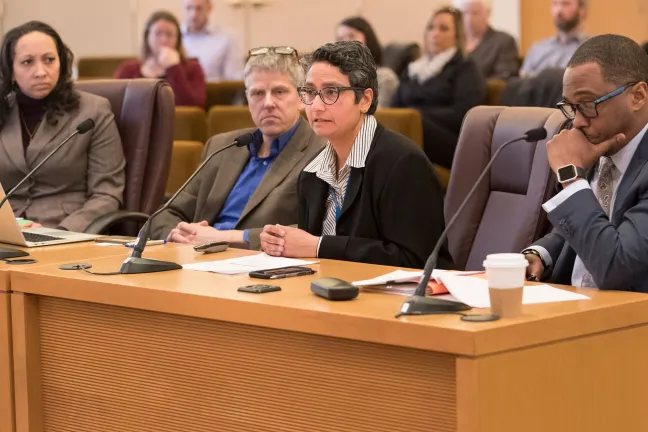In a third briefing on the leading causes of death in Multnomah County, public health officials laid out startling statistics on the deadliness of alcohol and drugs, firearms and traffic accidents.
Public Health Director Rachael Banks laid out the leading causes of death among residents ages 1 to 45, cautioning that the data alone masks the pain of so many people.
“Behind each number is a loved one, a family member,” she said during a presentation to the Board of Commissioners Feb. 26. “We know the impacts on the survivors are really profound.”
The briefings come as the County’s Public Health Advisory Board prepares to present policy recommendations to the Board March 7 to address chronic illness, preventable deaths and violence, and to promote programs that support community health.
“Thank you for putting this series together,” Chair Deborah Kafoury said Tuesday. “This is really allowing us to be thoughtful about how we approach our policy making.”
Deaths from alcohol and drugs
“We’re talking about some dry statistics, but there are individuals behind the statistics,” said Tri-County Health Officer Dr. Paul Lewis. “There are a real number of consequences for people who share their lives with those people.”
Alcohol is a more insidious threat than fast-acting opioids or methamphetamines, Lewis said. Alcohol-related deaths include acute poisoning, but more often come as a result of liver disease, cancer or other chronic conditions. Multnomah County’s rate of alcohol-related deaths is nearly twice high as the national average, Lewis said.
Opioids kill quickly — a person can die within minutes of an overdose — and the number of deaths have gone up in recent years. But opioid deaths still lag behind those from alcohol use, which are higher and have increased at a quicker pace.
“This raises the question do we have a special problem with alcohol?” Lewis said, “Opioids get a lot of attention, but alcohol looks like it's in competition. One thing I want to leave you with, we need to think about substance [abuse] more broadly.”
Methamphetamines deserve more notice too, Lewis said. More people die from opioid overdoses, but meth is surging in Multnomah County. It killed 70 people in 2017; nearly twice the national average.
“At $3 or $4 per dose and a purity rate of 90 percent, they’re not making it from cold remedies,” he said. “Now it’s really strong and really cheap.”
Commissioners said they were surprised by the leading role of alcohol in a state where pinot noirs and microbrews are seen as chic and hip.
“It’s something we don’t talk about,” said Commissioner Susheela Jayapal. “There’s a whole lot of culture around it. I appreciate the fact that such a bright light is placed on it in this presentation.”
Suicide
An average of 124 people commit suicide each year in Multnomah County, Dr. Nimisha Gokaldas, Medical Director for Mental Health and Addiction Services, told the Board. Fewer than half those who carry out suicide have a known mental health condition, but about three-in-four people who kill themselves have had trouble with drugs or alcohol.
And behind every completed suicide, an estimated nine more people considered suicide.
Suicide causes are complex, requiring a two-fold prevention strategy: increasing resilience factors such as building social connections and reducing risk factors such as addiction. One risk that stands out is access to firearms, the most lethal means of completing suicide.
Firearms and violent crime
Forty percent of suicides in Multnomah County are carried out with guns, which kill an average of 70 county residents each year, said Principal Epidemiologist Frank Franklin, Ph.D. Teens who commit suicide use guns more than any other means; and 80 percent of those guns came from their homes.
But access to guns doesn’t just triple the risk of suicide. It doubles the risk of homicide too. In fact, although vehicle crashes occur more frequently in Multnomah County, the risk of fatality from firearms is more lethal, Franklin said.
Traffic Deaths
While more people are killed by guns than cars in Multnomah County each year, traffic deaths illustrate the link between built environment and policies, said Public Health Director Banks. Most pedestrian deaths occurred on fast-moving arteries pumping East into downtown Portland. Nearly 60 percent of deaths occurred on 8 percent of city streets.
“This may prompt the question of who lives in those areas,” Banks said. An analysis by Metro found they are more likely to be people of color, more likely to be poor and more likely to be immigrants or refugees.
For every one person who is killed on Multnomah County roads, eight people are hospitalized, and 99 are treated and released from area emergency departments.
There are solutions, Banks said. They include engineering approaches such as building high visibility crosswalks, installing street lights at intersections, reducing the number of traffic lanes and installing roundabouts.
Commissioner Lori Stegmann, who lives in Gresham and represents east Multnomah County, said traffic fatalities are far too common in her district.
“It seems like weekly there’s a fatality and usually it’s a pedestrian,” she said. “These are sobering statistics. This is a crisis and with so many factors, we have to address them at every level.”


